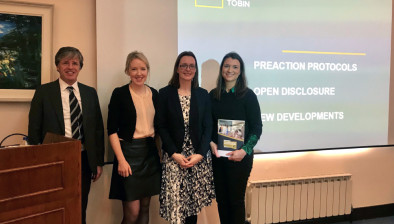James Stitt: Manufactured consent? A review of McCulloch v Forth Valley Health Board

James Stitt
Northern Ireland barrister James Stitt examines a Scottish case with significance for clinical negligence practitioners.
Once more, a Scottish case has provided an opportunity for a substantial development of the law in the field of clinical negligence.
McCulloch v Forth Valley Health Board [2023] UKSC 26 was an appeal from the Inner House of the Court of Session to the United Kingdom Supreme Court (UKSC) which addressed questions of patient consent in a legal landscape much altered by the totemic decision of Montgomery v Lanarkshire Health Board [2015] UKSC 11.
The background
Prior to Montgomery, the leading case on consent, Sidaway v Bethlem Royal Hospital Governors [1984] 1 All ER 1018, held the test for breach of duty was the professional practice test (aka the Bolam test): whether the doctor acted in accordance with practice regarded as proper by a responsible body of medical opinion.
The effect of this was to put the decision of whether to discuss the possible risks of a procedure with a patient solely in the hands of the medical profession, an approach characterised as ‘medical paternalism’. The autonomy of the patient was at best an afterthought. Such a status quo was bound to lead to instances of injustice, as was the case on the facts of Montgomery itself. In a nutshell, the UKSC in Montgomery rejected the old position of Bolam applying to consent cases and introduced a new test, founded on principles of patient autonomy and self-determination [at 87]:
‘The doctor is therefore under a duty to take reasonable care to ensure that the patient is aware of any material risks involved in any recommended treatment, and of any reasonable alternative or variant treatments. The test of materiality is whether, in the circumstances of the particular case, a reasonable person in the patient’s position would be likely to attach significance to the risk, or the doctor is or should reasonably be aware that the particular patient would be likely to attach significance to it.’
As with many great shifts in jurisprudence, the precise contours of Montgomery were not immediately clear. McCulloch is important as it was the first case to make it to the UKSC post-Montgomery, and the court did not shy away from tackling the issues.
The judgement addressed the limits of Montgomery and its relationship with the professional practice test, as found in the judgments of McNair J in Bolam v Friern Hospital Management Committee [1957] WLR 582 and Lord President Clyde in Hunter v Hanley 1955 SC 200 (the Irish equivalent being the ‘Dunne Principles’ derived from Dunne v National Maternity Hospital [1989] IR 91).
McCulloch
Mr McCulloch died from a cardiac arrest, caused by cardiac tamponade. Tamponade occurs when the sac which surrounds the heart (the pericardial sac) becomes engorged with pericardial fluid and prevents the heart pumping normally. In a healthy heart the pericardial sac contains a small amount of pericardial fluid which serves the purpose of lubricating the movement of the heart within the sac (the parietal pericardium). Inflammation can cause the pericardial sac to become excessively filled with fluid, a condition known as pericarditis. Pressure from this fluid accumulation can interfere with, and in some cases entirely prevent, the heart pumping, as was ultimately the case with Mr McCulloch.
Mr McCulloch was first admitted to hospital on 23 March 2012 displaying symptoms consistent with acute pericarditis. His symptoms worsened and the next day he was admitted to intensive care, intubated and ventilated. The impugned doctor, a highly experienced cardiologist, first became involved on the 26th when she was asked to review an Echocardiogram (ECG). The doctor’s notes from this date reveal she did not consider Mr McCulloch’s symptoms to be consistent with a diagnosis of pericarditis. She recommended his care should be continued under general medicine, rather than cardiology.
Mr McCulloch’s condition improved over the next few days, and he was briefly discharged home on 30 March before being abruptly readmitted by ambulance on 1 April, complaining of acute chest pain. The Emergency Doctor noted a likely diagnosis of pericarditis.
A further ECG was carried out on 3 April and reviewed by the cardiologist. While she noted minor changes, such as a small degree of collapse of the right atrium, the right ventricle and inferior vena cava however appeared to be functioning normally, suggesting an absence of tamponade. She considered the important issue was whether the effusion placed extra pressure on the heart, in the absence of such a finding there was no reason to suspect tamponade.
She visited Mr McCulloch again on 3 April to find him sitting up and feeling much better. In response to questions, he reported he was not experiencing chest pain, palpitations, breathlessness or any other symptoms that would give her cause for concern.
The notes showed she considered pericarditis and tamponade, but she concluded the symptoms did not convincingly indicate either condition. She was, and had been, aware of the excess pericardial fluid throughout her involvement with Mr McCulloch, but her interpretation of the ECGs and observations led her to conclude no specific treatment was required to deal with the fluid. Pericardial fluid often disappears without intervention. She discussed but did not recommend pericardiocentesis to Mr McCulloch. She never mentioned the option of treatment with non-steroidal anti-inflammatory drugs (NSAIDs).
Mr McCulloch was discharged home on the evening of 6 April. He died at home the next day from a cardiac arrest.
The case brought by the pursuer was that the cardiologist should have disclosed the treatment option of NSAIDs. Had she done so, Mr McCulloch would have opted to take them and this, on the balance of probabilities, would have reduced the pericarditis and prevented the tamponade which caused his death. The option of NSAIDs was not mentioned to Mr McCulloch as the cardiologist did not believe it to constitute a reasonable treatment option in the absence of any symptoms of pain. The legal question was essentially whether Bolam or Montgomery, or some novel hybrid thereof, was the correct test to apply to the disclosure of alternative treatments.
Montgomery transformed the law as it related to disclosure of risks of treatment. What Montgomery did not settle was whether its new quasi-subjective test should also apply to disclosure to the patient of possible alternative treatments which the treating doctor did not herself consider reasonable. If it did, the cardiologist would have been in breach of her duty of care to Mr McCulloch to fail to disclose the possibility of treatment with NSAIDs, even though she did not believe it to be reasonable. Evidence showed that while some responsible bodies of cardiologists would prescribe NSAIDs in these circumstances, others would not. The logical basis of neither camp could be undermined as per Bolitho v City and Hackney Health Authority [1998] A.C. 232.
The judgment of the court, delivered by Lord Hamblen and Lord Burrows, held the provision of information about alternative treatments was a matter of clinical judgement and should therefore be subject to the Bolam test and to hold otherwise in such circumstances would constitute an unwarranted extension of Montgomery. The cardiologist was therefore not negligent in failing to disclose the possibility of treatment with NSAIDs. The state of the law was explained by way of a hypothetical example at [57]:
‘A doctor will first seek to provide a diagnosis… Let us then say that, in respect of that diagnosis, there are ten possible treatment options and that there is a responsible body of medical opinion that would regard each of the ten as possible treatment options. Let us then say that the doctor, exercising his or her clinical judgment, and supported by a responsible body of medical opinion, decides that only four of them are reasonable. The doctor is not negligent by failing to inform the patient about the other six even though they are possible alternative treatments. The narrowing down from possible alternative treatments to reasonable alternative treatments is an exercise of clinical judgment to which the professional practice test should be applied.’
The reasoning for holding such was partly to effect continuity with Montgomery and Duce v Worcestershire Acute Hospitals NHS Trust [2018] EWCA Civ 1307 [63-66], and partly due to more practical factors, namely: consistency with GMC and BMA guidance [67-70], avoiding a conflict in the doctor’s role [71], avoiding bombarding the patient with too much information [72-73] and to provide legal certainty to doctors [74-77].
Montgomery drew a distinction between questions that concern the exercise of clinical skill and judgement versus the court-imposed duty to inform [59]. In Duce, a case decided post-Montgomery, Hamblen LJ (now giving judgment in the UKSC), applied Montgomery and demarcated a crucial distinction between two discrete aspects of the doctor’s role.
There it was stated knowledge of risks, and the duty to disclose those risks, must be subject to different tests. The former is measured against professional practice (Bolam), while the latter is a question for the courts (Montgomery). When this distinction is applied to the provision of information regarding reasonable alternative treatments, the court considered such a task was within the purview of professional practice, being an exercise in clinical skill and judgement, and patient autonomy would only become relevant after the doctor has disclosed the range of reasonable treatments. Once the menu of treatments (which may include a recommended treatment and the option of no treatment at all) is disclosed, only then does Montgomery with its subjective test of materiality apply.
At hearing, counsel for McCulloch argued that to apply Bolam to the potential range of possible tests would restrict patient autonomy by taking certain treatment options off the menu prematurely. To present a patient with a range of treatments considered reasonable by the doctor but fail to mention other treatments, which might have been favoured by a different doctor, would inevitably inhibit patient autonomy as they would not know about potential treatments that had not been disclosed. It was further argued the Bolam test would have its place in assessing possible treatments, but it would be the court who would judge, assisted by expert evidence, whether the range of reasonable potential treatments disclosed to the patient was negligent. The court rejected this interpretation of the authorities [65-66].
The court entertained possible qualifications to the duty to disclose information about alternative treatments [79-81].
One qualification which might have struck a balance between professional practice and patient autonomy would have been the inclusion of a duty for doctors to disclose the existence of alternative treatments which they know, or ought to know via constructive knowledge, is considered reasonable by another responsible body of medical opinion – a ‘qualified Bolam test’ (QBT). From the patient’s perspective they would be alerted to another option and may choose to seek a second opinion. Their doctor would still be perfectly able to explain why he considered this other treatment option to be unreasonable in the circumstances – he would not be bound to endorse it or stay neutral.
The argument against this qualification is that it renders the scope of the doctor’s duty less certain and there could be conflict in the doctor’s role [71 and 81]. For these reasons the court rejected the QBT and endorsed a straightforward application of Bolam.
Did the court strike the right balance?
Some might argue the following: in practice Doctor A will, on occasion, fail to disclose certain treatment options that he considers unreasonable, even though he knows Doctors B and C take a different view. In a certain proportion of such cases, the undisclosed option may have been the lifesaving or disability preventing treatment.
The rejection of the QBT in McCulloch, will mean a lifesaving treatment known to the doctor, but judged by her to be unreasonable in the circumstances and thus never disclosed to the patient, could not amount to a breach of duty. The opportunity for the patient to reflect on his options and consider seeking a second opinion would be missed. A patient who has sustained a potentially catastrophic loss will be unable to seek compensation.
The opposite approach — for a doctor to advise on all possible treatments — is clearly too great an expansion of the principle of patient autonomy, but this point was never seriously argued. Under the QBT, the doctor would be required to reflect on a broader range of treatment options than is currently the case. Whether such a duty is a realistic or fair imposition on an already highly demanding profession is moot.
The concern about conflicts in a doctor’s role, I would argue, is misplaced as the duty to disclose is not a duty to endorse any particular treatment. The doctor is free to recommend only those treatments which she considers reasonable and cannot be compelled by a patient to act against her professional judgement. It is notable the cardiologist in McCulloch discussed what, in her judgment, was an unreasonable treatment option (pericardiocentesis) with the patient. There was no question that disclosing a possible treatment could be conflated with recommending a possible treatment.
Irrespective, the court took a different view and declined to endorse a QBT, missing an opportunity to shape the law in a manner which promotes patient autonomy, whilst incorporating aspects of Bolam. Montgomery emphasised the importance of this new approach only eight years ago, the McCulloch judgement however reveals Bolam/professional practice remains the default test in all but a very narrow set of circumstances.
Doctors will breathe a sigh of relief following this judgment. The profession and its regulators would have been anxious to prevent a further expansion of liability.
While the court’s judgment leaves some potential plaintiffs without just recourse to the law, there are sound reasons why the court decided as it did. Beyond the issues of legal certainty, regulator guidance and conflicted duties, it is notable there was minimal comparative authority supporting the pursuer’s case.
Montgomery relied heavily on Australian and Canadian caselaw. Pre-2015, the UK lagged behind similar jurisdictions but following Montgomery, it has now caught up. Only one comparative case, from the Alberta Court of Appeal (Seney v Crooks 1998 ABCA 316) was uncovered supporting the expansion of the duty to cover disclosing alternative treatments which the treating doctor did not consider reasonable.
Domestically, the Sherriff Court decision of Bitten v Tayside Health Board [2016] SC DUN 75 was the sole dissenting authority relied upon by the pursuer. The paucity of judicial endorsement is perhaps itself a sign that liability in this area has developed as far as it is going to go.
The court in McCulloch found itself in a difficult position. It was charged with striking a balance between two important principles: promotion of patient autonomy versus the concern of the medical profession over expanded liability and legal uncertainty. No perfect solution existed which would wholly satisfy both sides of the argument.
By endorsing the application of Bolam in these circumstances, the court has limited the effect of Montgomery in such a way that most neutral observers would acknowledge as both reasonable and proportionate, reflecting the practicalities of the doctor-patient relationship and respect for clinical judgement.
- James Stitt is a barrister in Northern Ireland whose practice includes personal injury and clinical negligence litigation.







